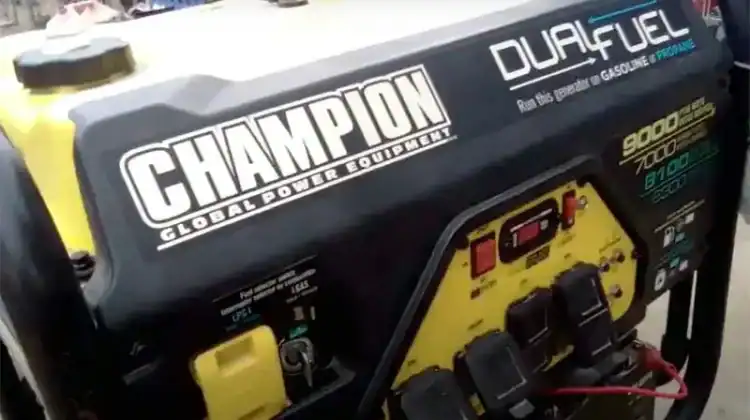
Thank you for reading our post, please rate this article at the end.
Reading Time: 8 minutesLast Updated on October 16, 2025 by Jonathan Holmes
Table of Contents
10 Reasons Your Generator Backfires and DIY Fixes
Key Takeaways
-
- Definition and Impact: Generator backfiring occurs when the air/gas mixture ignites at the wrong time or doesn’t combust properly, potentially damaging the engine (like the combustion chamber and piston) and voltage-sensitive appliances.
- Common Causes (10): The primary causes of backfiring include:
- Early Combustion/Pre-ignition: Ignition occurring prematurely, often due to hot spots, incorrect spark timing, a lean mixture, or stale fuel.
- Air-Fuel Mixture Issues: A lean mixture (too much air) or issues leading to it, such as a faulty/clogged carburetor, incorrect choke position, or air leakage (from seals/filters).
- Ignition Problems: A faulty spark plug that doesn’t ignite the fuel in a timely or correct manner.
- Fuel Quality/Supply: Low or stale fuel (over 3 months old) loses combustibility.
- Valve/System Faults: Malfunctioning intake valves or a closed/faulty fuel valve.
- Exhaust Issues: A blocked or damaged exhaust system/muffler causing backpressure or ignition of unburned fuel.
- DIY Fixes/Maintenance: Most backfiring issues can be resolved with basic maintenance:
- Fuel Management: Use fresh, high-octane fuel or normal fuel with a stabilizer. Drain old fuel.
- Carburetor/Mixture: Clean and adjust the carburetor and ensure the air-fuel ratio is correct. Check for vacuum leaks or clogged filters.
- Spark Plug: Inspect, clean, or replace a faulty spark plug and ensure the gap is correct.
- Timing/Combustion: Adjust ignition timing and clean carbon deposits from the combustion chamber to prevent hot spots.
- System Checks: Ensure the choke is in the correct position (“Closed” for start, “Open” after warming), the fuel valve is open, and the exhaust system is clear and leak-free.
- Seals/Filters: Replace damaged seals and air filters to prevent air leakage.
- Afterfire (Shut-Off Backfire): Backfiring after the generator is turned off is called afterfiring or afterburn. It’s often caused by unburned fuel igniting in the exhaust due to a rich air-fuel mixture, clogged air filter, fuel system malfunctions, faulty exhaust components, delayed combustion, or high engine temperature.
A backfired generator not only impacts performance but can also reduce the machine’s lifespan and harm voltage-sensitive appliances like chargers, microwaves, laptops, etc.
“Backfiring occurs when the mixture of gas and air ignites at the wrong time or doesn’t combust properly.”
Fortunately, backfiring can be fixed at home by performing basic maintenance, such as cleaning the carburetor, spark plug, filters, and fuel lines, among other components.
Below is the list of the top 10 most common causes of the generator’s backfiring with DIY fixes.
Why is My Generator Backfiring? 10 Causes With DIY Fixes
1. Early Combustion:
Early combustion/pre-ignition can be a prominent reason behind the generator’s backfiring.
Pre-ignition occurs when the air-fuel mixture within the engine’s cylinder ignites prematurely, causing knocking sounds, backfires, sputtering, etc.
Hot spots in the cylinder, improper spark timing, a lean air-fuel mixture, and poor/stall fuel could trigger pre-ignition.
Solution:
Below are the maintenance tasks to prevent the machine from Early combustion/pre–ignition. 
- Adjust the ignition timing according to the manufacturer’s specifications.
- Inspect the condition of the Spark Plug. If you find carbon deposits or damaged electrodes, make sure to replace the spark plug.
- Use Fresh high-octane fuel or at least a normal fuel with a fuel stabilizer. Poor/Stale fuel will not only hurt the longevity of the machine but also contribute to early combustion.
- Cleaning the carbon deposit from the combustion chamber can help prevent hot spots.
- Do an Inspection of the Combustion Chamber, and ensure its design is optimal and free from irregularities.
If the problem is still there, consult with a Professional or claim the warranty.
2. Lean Air Fuel Mixture in the Carburetor:
A lean air-fuel mixture can also be a leading cause of unburnt fuel being transported to the exhaust system, where it starts combustion.
When the unburned fuel ignites in the exhaust system, it causes a sudden release of energy. This release of energy creates a loud popping sound or even flames shooting out from the exhaust pipe, known as a backfire.
Solution:
- Ensure the carburetor or fuel injection system is properly adjusted to maintain the correct air-fuel ratio.
- Inspect the carburetor and clean it properly. If you find something damaged, make sure to replace or repair it.
- Check for other potential causes of lean fuel, such as vacuum leaks and clogged fuel filters.
- Schedule routine maintenance.
3. Faulty or Clogged Carburetor:
The carburetor is the primary component that ensures the combustion chamber receives a sufficient amount of fuel with the proper air-to-fuel ratio.
If the carburetor is clogged or faulty, improper combustion will occur, leading to poor engine performance, difficulty starting, and backfiring, among other issues.
Solution:
- Dismantle the carburetor and carefully clean its jets, fuel lines, and other components so that the air and fuel can pass smoothly.
- Schedule cleaning of the carburetor.
- If you find damaged seals, jets, or fuel lines, make sure to replace them.
4. Faulty Spark Plug
A Worn-out or Faulty Spark Plug with a fouled or damaged electrode might Not Ignite the Fuel in a timely manner, causing difficulty in starting, Misfiring, poor efficiency, and backfiring as well.
might Not Ignite the Fuel in a timely manner, causing difficulty in starting, Misfiring, poor efficiency, and backfiring as well.
Note: A faulty spark plug can also be a leading cause of fluctuating voltages that may hurt your voltage-sensitive appliances like air conditioners, refrigerators, laptops, etc.
Fareed (Freddy), COO of Safepowering, has written a detailed guide about selecting a perfect-sized generator to run an air conditioner. Make sure to have a look.
Solution:
- Turn off the generator, remove the spark plug, and inspect its electrode. If you find it damaged, replace the spark plug.
- Ensure the spark plug gap (the distance between the center and ground electrode) matches the manufacturer’s specifications.
- If the spark plug is dirty, clean it using a spark plug cleaner.
5. Choke Is at the Wrong Position:
The purpose of a choke is to control the flow of air to the carburetor, ensuring a proper blend of oxygen and fuel is fed to the combustion chamber.
If the choke/lever is in the wrong position, the generator may overheat, sputter, backfire, or experience irregular RPMs.
Solution:
Locate the choke/lever on your generator. Typically found on the side and positioned above the air filter, some models cleverly incorporate this lever into the power knob.
Make sure the choke is set to the “Closed” position. As the engine warms up over the first few seconds of operation, after warming, the choke should be at the “Open” position to ensure a sufficient amount of air is transported to the carburetor for smoother operation.
6. Faulty Intake Valves:
The sole purpose of intake valves is to control the flow of air and fuel to the combustion chamber.
If the intake valves malfunction, mainly sticking or not closing properly, the combustion timing can be disturbed, resulting in lower output, reduced runtime, or backfiring.
Solution:
- Inspect the physical condition of the intake valves, and replace or repair them if you find any physical damage. We recommend consulting with a generator mechanic for better assistance.
- Clean the valve and its components to remove any dirt, debris, or carbon buildup that might be affecting its smoother operation.
- Adjust the valve times or clearance as per the manufacturer’s guidelines.
- Make a schedule of regular maintenance.
7. Low or Stall Fuel:
Low or old stall fuel can be a leading cause of not only the generator’s backfiring but also sputtering, low performance, etc.
If the generator runs out of fuel, it may start backfiring due to insufficient fuel for combustion. Also, if the fuel sits for more than 3 months, it becomes stale and loses its combustibility due to increased moisture content.
Solution:
- Check the fuel gauge or fuel level manually, as we sometimes forget to refill the machine.
- If you suspect that you have poured more than 3 months old fuel, chances are that fuel was stalled, make sure to drain the old fuel from both the carburetor and fuel tank, pour some high-octane fresh fuel, and run the machine for about 5 to 10 minutes.
- Store the fuel in a properly labeled air-tight container so that there is no entrance for moisture and contamination, also Stick a piece of duct tape on the container with the purchased date of the fuel.
- Don’t use fuel that is more than 3 months old.
- Must use a fuel stabilizer for better performance. I mostly pour the stabilizer right into the fuel tank.
8. Exhaust System Issues:
A blocked or damaged muffler can cause unburned fuel to ignite within the exhaust system or produce backpressure that affects the Engine’s Performance and leads to Backfiring.
Solution:
- Turn off the generator and leave it for a while to cool down, Monitor the visual condition of the exhaust system, if you find a leak or damaged muffler, pipes, or other connection, make sure to repair or replace it.
- Restore the airflow by cleaning the blockages and rust.
- If you find a leakage, use exhaust system repair kits, heat-resistant sealants, or clamps to seal leaks.
- Tighten the loose parts of the exhaust assembly.
- Incorporate regular exhaust system inspections/maintenance.
9. Faulty Fuel Valve:
The fuel valve is responsible for restricting or allowing the fuel to the carburetor.

If it’s not functioning well or closed, a lean air and fuel mixture may be fed to the combustion chamber, causing backfiring, irregular RPMs, lower output, etc.
Solution:
Open the fuel valve to the recommended position, and ensure you inspect its physical condition and connections to the carburetor and fuel lines.
10. Air Leakage:
Excessive air intake from the leaked seals, improper choke position, and filter leakages could disrupt the air-to-fuel ratio, leading to backfiring and excessive vibration.
Solution:
- Replace the broken or damaged seals and keep the choke in the right position as per the weather conditions.
- Seal any leakage with the recommended heat-resistant material.
- Replace the damaged air filter.
Can a Backfire Damage a Generator’s Engine?
Yes, backfiring can potentially damage a generator’s engine, especially parts like the combustion chamber and piston, which are costly to repair or replace.
Addressing the backfiring plays a vital role in not only providing super-smooth operation but also improving the longevity, efficiency, and output of the generator.
Can Backfire Damage the Power Valve?
Yes, due to excessive stress, the backfiring can potentially damage a power valve in the internal combustion engine.
Why a Generator Does Backfire When You Shut It Off?
After turning off a generator, backfiring can happen if there’s extra unburnt fuel in the engine and the piston still has some motion left.
When the generator is running, the air-fuel mixture ignites properly. However, if we shut down the generator suddenly, the fuel in the engine may not have had the chance to burn completely, resulting in backfiring (also known as after firing).
What Causes Generators to Afterfire?
The following factors could contribute to Generators after firing or Afterburn.
-
Rich Air-Fuel Mixture:
When there is unburned fuel available in the exhaust system, it can continue to burn after the engine is turned off. This can be caused by a rich air-fuel mixture (more fuel than required).
-
Clogged Air Filter:
A clogged air filter blocks the airflow to the carburetor, causing a lean air-fuel mixture to be fed to the combustion chamber.
-
Fuel System is Malfunctioning:
A clogged fuel filter, fuel lines, or a malfunctioning fuel pump could also contribute after firing, as there is no proper air and fuel mixture available for proper combustion.
-
Faulty Exhaust Components:
Issues such as a damaged or worn-out muffler, exhaust manifold, or catalytic converter can contribute to after-fire. These components might retain heat and create conditions for post-shutdown combustion.
-
Delayed Combustion:
Like backfiring, delayed combustion can also be a leading cause of the after-firing.
If the spark plug does not provide ignition within the correct time frame, unburned fuel can be burned in the exhaust system, resulting in after-firing.
-
High Engine Temperature:
If the engine’s temperature is elevated due to prolonged operation or other reasons, the heat can cause unburned fuel to ignite in the exhaust system.
Generator Backfiring Vs. After fire
| Aspects | Generator Backfiring | Generator Afterfire |
|---|---|---|
| Timing | During engine operation | After the engine has been turned off |
| Sound | Popping, banging, or bursting sounds | A popping or banging sound from the exhaust |
| Cause | Incorrect ignition timing, fuel mixture, clogged carburetor, faulty fuel valves, etc. | Unburned fuel igniting in hot exhaust |
| Combustion Location | Within the engine’s cylinders | Within the exhaust system |
| Harmfulness | Can be harmful and indicative of problems | Generally harmless, but can indicate issues |
This video has been included for its clarification of the topic matter. Credit goes to James Condon
Final Thoughts
Your generator backfiring signals a combustion issue, primarily resulting from the air-fuel mixture igniting prematurely or incorrectly. This problem can severely impact performance, longevity, and attached electronics.
The top 10 causes pinpoint issues in the fuel system (stale/low fuel, faulty carburetor/valve), the ignition system (faulty spark plug, incorrect timing), the air intake (wrong choke position, air leaks), and the exhaust system (blockages/damage).
Fortunately, the article emphasizes that the majority of these issues are preventable and fixable through basic, routine maintenance, such as using fresh, stabilized fuel, cleaning the carburetor and spark plug, and ensuring correct settings for the choke and ignition timing.
If basic maintenance doesn’t resolve the issue, especially with internal components like intake valves, professional consultation is advised.







